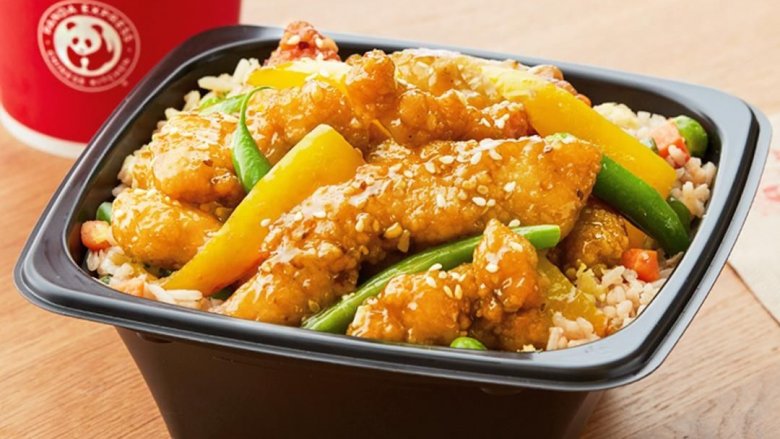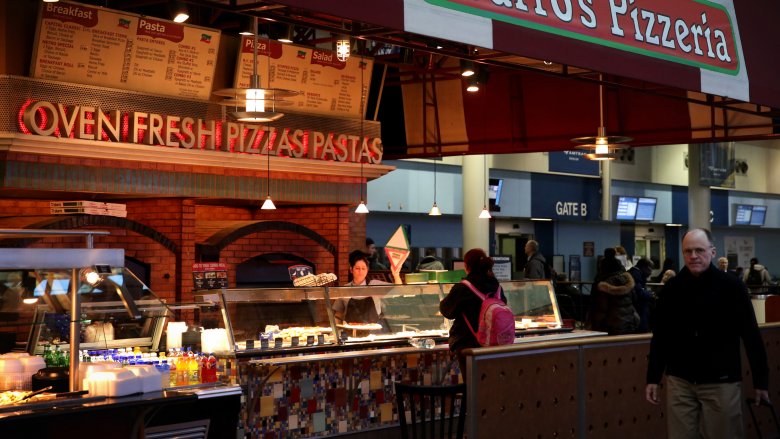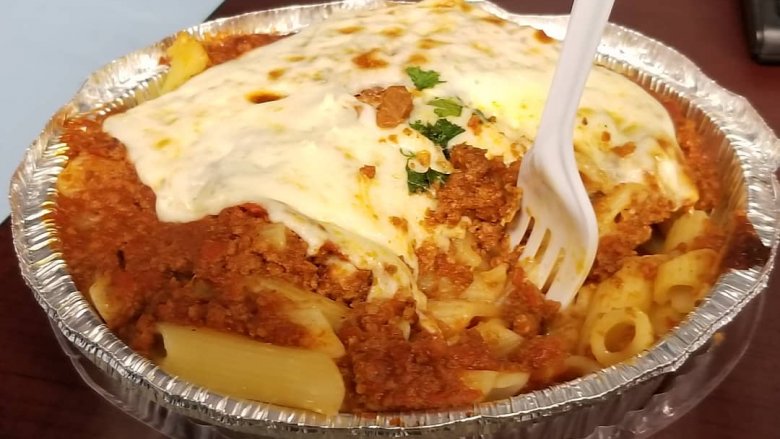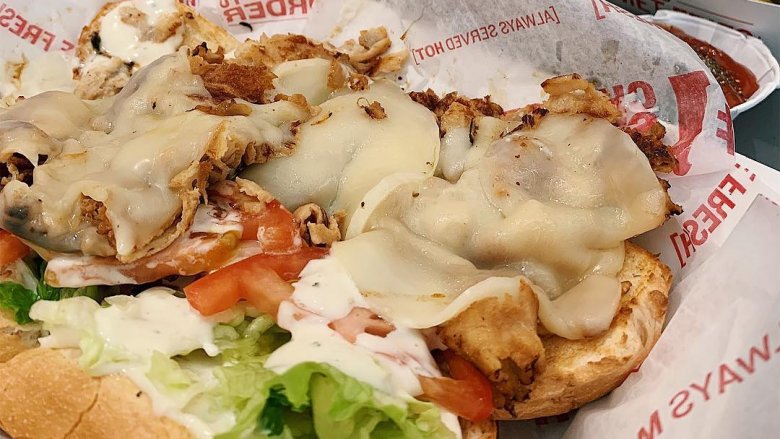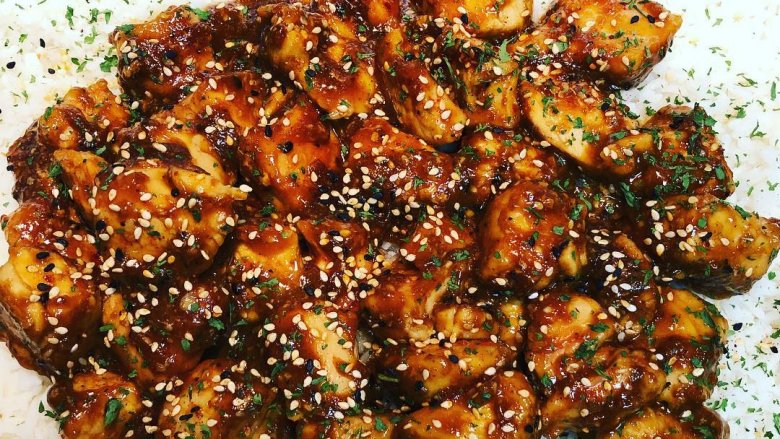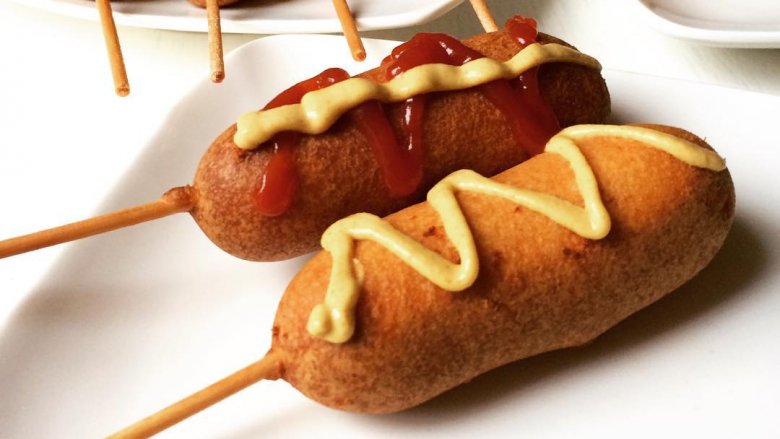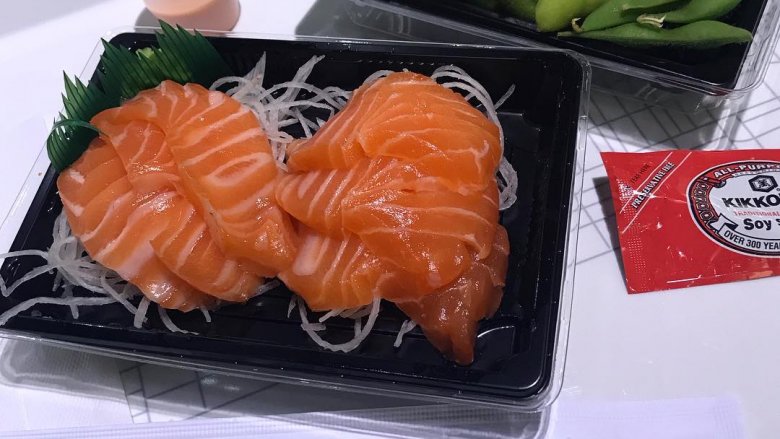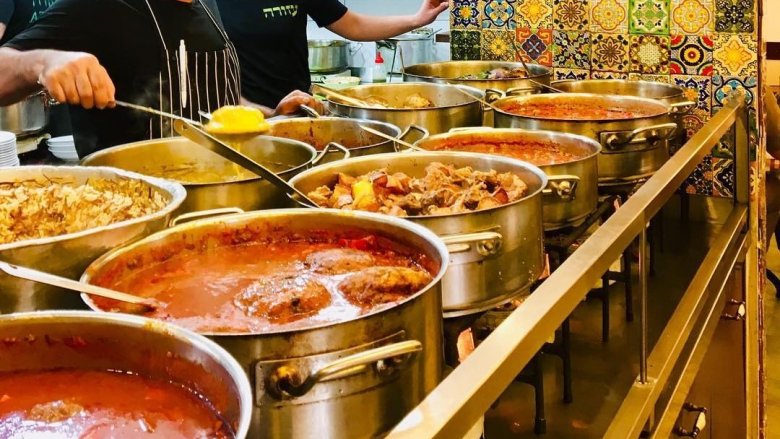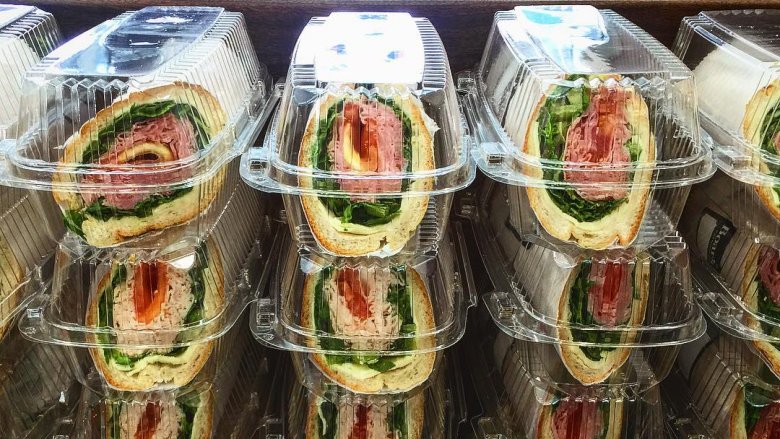Food Court Food You Should Never Eat
For most of us, a day trip to the mall ends the same way. Once your shopping agenda has been met, it's hard to figure out what to do next. You've probably already thrown a few coins in the fountain by the elevators. You've checked the showtimes for the sketchy mall movie theater, and surreptitiously made faces at the toddlers riding the indoor carousel. Finally, it hits you: It's time to grab something to eat at the food court.
Hunger strikes nearly everyone at the mall, sooner or later. But the choices we make there are critically related to how we'll end up feeling for the rest of the day, whether we'll feel recharged my nutrients surging through our bloodstreams, or bloated, lethargic and mildly depressed as our overworked cardiovascular system tries in vain to figure out how to process a cheesesteak. Or maybe you'll just be angry that you wasted your hard-earned money on something that didn't taste half as good as you thought it would. The decision you make at the food court is important. We're here to help.
Candy chicken
Do you know why there's always the oldest woman you've ever seen in real life standing just outside the melee of the chain Chinese restaurant buffet, handing out samples of Orange Chicken, Sweet and Sour Pork, or General Tso's Chicken speared on tiny toothpicks? It's because these sweet-shellacked morsels of deep-fried meat (which we kind of collectively mentally refer to as "candy chicken," regardless of the sauces or proteins in play) tastes like the greatest thing ever cooked by man, if you eat just one bite of it, at the moment it is piping hot, crispy, and fresh. That one sample bite will be enough to convince you that all of the time you've spent in your life eating anything else has been wasted, and your body will steer you toward ordering a combination plate before your brain has even had a chance to weigh in on the matter.
Unfortunately, that first perfect bite is as good as it's going to get. Without fail, your candy chicken will cool from 240 degrees to somewhere just south of room temperature the moment it hits that Styrofoam container, and even the slow march around the food court, searching for a table, will be enough time to transform your exotic lunchtime treat into a soggy mass of gloppy, spongy, sugary goo. The sharp drop-off in deliciousness between "ordering" and "sitting down" is truly remarkable, and makes this dish a tempting but ultimately poor choice.
Food warmer pizza
For pizza chains desperate to crack the food court puzzle, the solution seemed simple: Make pizza available, without making customers wait to have dough tossed around in the air, layered with cheese and toppings, and cooked in a high heat oven. After all, mall shoppers have a packed day of shopping for $200 stainless steel hazelnut cocoa machines at Williams-Sonoma ahead of them; they can't be expected to wait around while their fresh food cooks. Making a few pizzas ahead of time, keeping them warm, and selling them by the slice must have made a lot of sense.
The problem here is volume. If you're hitting the food court during peak mealtimes, these pizzas are turning over pretty quickly, and you're able to get a fresh-ish slice pretty quickly. But hit the mall in the mid-afternoon, and there's no telling how long those tepid slices of decaying meatball pizza have been congealing into an oily mass under the warmer. And no, pizza guy, putting that single sad slice back in the oven for 40 seconds before serving it isn't fooling anyone. If you're eating mall food court atrocities, the least you can do to love yourself is insist on eating food that's made to order.
Pre-cooked pasta dishes
While we're on the subject of "crimes committed against Italian food by third-tier chain restaurants," let's also pause for a second to talk about those gigantic steam table trays of baked ziti, eggplant Parmesan, or spaghetti and meatballs that are often riding shotgun next to the floppy slabs of Sicilian-style slices. Basic food safety issues aside (you wanna tell us that some underpaid pizza geek is checking the internal temperature of that heaping bale of manicotti every 15 minutes, to make sure it's holding at 140 degrees?), these dishes are also a nutritional minefield.
Look, we get it; you've had a tough day of spending money. But unless you're an Olympic athlete, you don't need to pile 1,200 calories worth of sugary carbohydrates down your gullet in one sitting. These dishes aren't going to energize you for more shopping; they're going to make you want to get home as soon as possible to get some sweatpants on before the next episode of Property Brothers starts.
Cheesesteaks
There are few things finer in this life than a balanced, freshly-made, piping hot Philly cheesesteak: Those delicate tendrils of seasoned, thin-sliced ribeye steak, cut against the grain so that your teeth neatly shear through each bite, sautéed with a scattering of translucent, caramel-colored diced onions, all enrobed in a smooth layer of provolone or (even more ideally) Cheez Wiz, the disparate elements fusing the sandwich's filling into a singular mass of cheesy, fatty, greasy perfection. It's the vision of this platonic ideal that inspires us to try a food court cheesesteak every once in a while, and it's a mistake almost every time.
Where do we begin to enumerate the problems? Bland, sub-grade, unseasoned meat that pulls out of the sandwich in big pieces, searing steak-shaped welts onto your unsuspecting chin. Big strings of over (or under) cooked, bitter onions. An application of cheese that amounts to little more than a gesture, perched sadly and half-melted on top of the sandwich's other ingredients, served on a roll that was delivered somewhere between six and 60 days ago. Food court cheesesteaks never live up to the promise of the versions sold in Philadelphia (or even at your favorite sandwich shop), and for that reason, they earn a "pass" from us.
Cajun food
Here's what Cajun food is: After you step sunburned off an airboat tour of the local swamp, an old man with all of his front teeth missing, skin that looks like a deflated football, and who insists on calling you "chère" spoons you up huge scoops of étouffée that he spent all night cooking in a metal trash can lid over a campfire with crawfish, some scraps of Andouille sausage that his brother-in-law grinds in his garage, and pieces of an alligator that he wrestled to death that morning, served with a piping hot cup of strong, bitter coffee made from equal parts coffee bean, chicory, and pure gasoline, with a grease-soaked bag of lighter-than-air powdered sugar-dusted beignets to take with you for the ride home.
You know what Cajun food ISN'T? Chicken chunks drenched in sticky sweet artificial "bourbon" flavoring, with an extra large fountain Mountain Dew. With food, context is key, and if there's one rule that we try to live by, during our time on this big blue marble, it's this one: You shouldn't be eating pretend "Cajun" food and browsing for Panic! At the Disco t-shirts at Hot Topic on the same afternoon.
Corn dogs
Corn dogs address a problem that doesn't exist; that is, how to translate the full-service, sit-down luxury experience of "eating a hot dog" into a more portable snack that can be eaten on the run. That's why so many corn dog restaurants have to employ teenagers in outlandishly tall, colorful hats; they're trying to distract you from the fact that they sell a product that has no reason to exist.
Sigh. Okay, we understand how you can make the case for battering and frying a hot dog in cornbread, and then serving it on a stick, since it's been scientifically proven that any food eaten from a stick is at least 140 percent more awesome. But there's no excuse for food court corn dogs to be as bad as they are. Whether it's old, sour, bitter fry oil, under-cooked batter that's still wet and raw in the middle, or using the lowest possible quality hot dogs legally allowed to be sold for human consumption, a corn dog is almost always a high-calorie "snack" that will leave you unsatisfied, a little bit queasy, and craving a real meal within the hour.
Soft pretzels
The hot pretzel stand always manages to reel us in, and it's almost always a mistake. There's something about that smell of melted butter and those big chunks of kosher salt that can make pretzels feel like just the kind of fuel we need to get through the afternoon. A few bites into your pretzel however, you'll realize you've made a terrible mistake, as that wad of undercooked complex carbohydrate begins its slow swell up your esophagus, making each chew more difficult than the last. Sure, you can beat this condition back with a throat-lubricating swallow of flavorless nacho cheese sauce to make the whole thing more palatable, but WHAT ARE YOU EVEN DOING.
For the budding amateur scientists in our audience anxious to test this theory at home, we propose a highly-controlled experiment. Go to the mall and buy a soft pretzel. Then, take it outside and throw it into a muddy puddle. Come back the next day, and see what it looks like. Yep: That's just what that pretzel is doing in your stomach, only when it's in your body, it happens much more quickly, since your stomach is probably also filled with highly-carbonated energy drinks.
Dippin' Dots
So far in this rundown, we've taken great pains and gone to frankly admirable lengths to avoid being critical of specific brands. But in this instance, we have to make an exception, because DIPPIN' DOTS ARE AN ABOMINATION THAT EXISTS IN STRICT DEFIANCE OF GOD'S WILL.
For the blissfully uninitiated, Dippin' Dots has promised since its invention in the 1980s to be "the ice cream of the future," which is a slogan predicated on the idea that in the future, ice cream is basically terrible. Instead of the cool, creamy treat that Americans have loved for generations, in the future, ice cream base will be flash-frozen in liquid nitrogen into tiny spherical beads that are guaranteed by their very design to give you an instantly crippling ice cream headache, while being neither "delicious" nor "fun to eat" nor by definition even really "ice cream." Devoid of richness, flavor, or any of the other elements that make us want ice cream in the first place, the Dippin' Dots kiosk is definitely one place to skip on any trip to the mall.
Sushi
Sushi can be as sophisticated, artful and nuanced as a work of fine art, each slice of the sharply-honed knife sliding perfectly cleanly through vividly-colored gossamer ribbons of fatty tuna belly, arranged on the plate with all of the attention and artistry of a master oil painter. Sushi can also be perfectly good, we would argue, when it's rolled clumsily into wads of gluey rice and topped with buckets of mayonnaise and wasabi, eaten standing up while pumping gas into your high-mileage Ford Fiesta. But at both ends of the quality spectrum, good sushi has to be just one thing: It has to be fresh.
Now, we don't know anything about the relative skill or background of the sushi chef that finds himself pulling food court duty at the local mall, paying his dues for sushi crimes unspoken with his life sentence of slinging endless California rolls to suburbanites, and responding to questions of "Wait, you mean it's RAW?" at least 100 times per day. But we can be pretty sure of one thing: That guy ain't trotting down to the fish market at dawn every day to ensure the freshness and quality of his product. You can play Russian roulette with your digestive system in a lot of interesting and worthwhile ways, but food court sushi isn't one of them.
Smoothies
Smoothies are arguably one of the healthier choices for a quick, satisfying snack at the mall food court. Sure, many of them tend to be higher in calories and sugar than one might expect from simple combinations of fruit, vegetables, juice, and dairy. But at least they're natural, right?
The trouble is that because the local wheatgrass whirlers have to compete with the sights and smells of the shops around them, each one selling iced chocolate chip cookies the size of trash can lids and tractor tire-sized mountains of cinnamon roll dough and dripping frosting, many of the so-called "healthy" smoothie shops have been augmenting their offerings with some decidedly unhealthy add-ins. Because sure, strawberries and yogurt may make a good smoothie. But you know what makes it even better? Adding in a scoop of peanut butter, some dark chocolate protein powder, a drizzle of caramel, an entire Butterfinger, 40 marshmallows, and some rendered animal fat. Before you know it, your "healthy" snack can clock in at 1800 calories, and leave you feeling sluggish and lethargic for the rest of the day.
Those weird local startup restaurants
We certainly understand the temptation, for feisty young food entrepreneurs anxious to gain a foothold in the restaurant industry. Filled with ideas, enthusiasm, and the conviction that their unique take on waffles/gourmet soup/paninis are going to set the culinary world on fire, but lacking the deep pockets or investors necessary to bring their dream to life, establishing a foothold for their new business in the mall food court probably seems like an inexpensive way to guarantee foot traffic.
All of that bright-eyed enthusiasm can make for some pretty inventive combinations not found at the other places in the food court. Normally, we'd be all for taking a break to appreciate the cheffy pedigree of the guajillo chile reduction lovingly splashed onto that pork belly panini, and we'd usually be fascinated in hearing more about whether or not the kale used in your weirdo organic soup that costs $9 per pint was grown without the use of pesticides. The trouble is, after a day spent wondering about more pressing fashion decisions ("Are cargo shorts ever coming back? Am I too old for skinny jeans? UGGs or nah?"), we're usually too mentally exhausted for all of that earnestness and zest for life.
Pre-made sandwiches
Pre-made sandwiches are a bummer. Overall quality is almost always an issue, with ingredients including soggy, limp, brown lettuce, mealy slices of colorless tomatoes, dried-out pickles, and cheese that has liquefied and fused into the surface of a few lifeless grey slices of meat that could have come from basically any animal, served on insipid slabs of wet, chewy bread. But our biggest objection to the pre-made sandwich isn't even necessarily one of quality; it's the absence of choice.
Sandwich enthusiasts (and the marketing gurus at Subway or Quiznos) know that a major part of the appeal of a sandwich lies in its customizability. We don't want to eat what someone ELSE has chosen to put on our sandwich; we want the freedom to add black olives, or pickled jalapeños, or an extra scoop of tuna. We want chipotle peppercorn sauces and six different options for bread and pepperjack cheese. Or none of that, at all. And in this day and age, in THIS MALL FOOD COURT, that's our right and our privilege and our expectation. Because this is America, we're shopping, we're hungry, and gosh darn it, honey mustard is gross.

